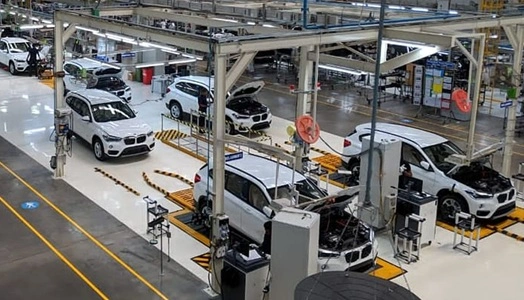The Indian automobile industry stands at a transformative juncture in 2025, driven by innovation, government policy support, increasing consumer aspirations, and a clear shift towards sustainable mobility. As the third-largest automobile market in the world after China and the US, India’s auto sector plays a pivotal role in the country’s economic development, contributing over 7% to the national GDP and employing more than 35 million people directly and indirectly.
With rapid urbanisation, a young and tech-savvy population, and a surge in electric vehicle (EV) adoption, the automobile sector is evolving like never before. The Union Budget 2025 has further boosted the industry’s prospects by announcing incentives for EV manufacturing, expanding charging infrastructure, and promoting green hydrogen. As companies invest in R&D and digital transformation, India’s auto industry is not only looking inward but also becoming a major export hub.
In this context, let us dive deep into the SWOT analysis of the Indian automobile industry in 2025.

Strengths
1. Large Domestic Market
India’s massive population and growing middle class provide a strong domestic demand base. With over 300 million people in the middle-income bracket and rising aspirations for personal mobility, both entry-level and premium segments are witnessing steady demand. Two-wheelers, small cars, and SUVs continue to dominate sales.
2. Established Manufacturing Base
India is known as a global manufacturing hub for automobiles. Major global players like Suzuki, Hyundai, Kia, Toyota, and Mercedes-Benz have set up plants in India, leveraging cost advantages and skilled labour. The “Make in India” and “Atmanirbhar Bharat” initiatives further strengthen this base.
3. Thriving Auto Component Industry
The Indian auto component sector is robust and globally competitive, with exports reaching $22 billion in FY24. It supports vehicle manufacturers with a well-integrated supply chain network and contributes significantly to the industry’s value chain.
4. Growing EV Ecosystem
With schemes like FAME-II and PLI for Advanced Chemistry Cells (ACC), the EV sector is gaining momentum. Startups like Ola Electric and legacy players like Tata Motors and Mahindra are rapidly innovating in the EV space. Tata’s Nexon EV and Tiago EV have emerged as top-selling models in 2024-25.
5. Export Potential
India has become a key exporter of small and compact cars, particularly to emerging markets in Africa, Latin America, and Southeast Asia. The expansion of shipping ports and free trade agreements (FTAs) are further boosting exports.
Weaknesses
1. Infrastructure Challenges
Despite progress, India’s road infrastructure, public charging facilities, and logistics still pose hurdles. In tier-2 and tier-3 cities, poor road conditions and limited service centres hamper vehicle performance and consumer confidence.
2. High Taxation
Automobiles in India attract one of the highest tax slabs under GST (28% + cess), especially for luxury cars and SUVs. This inflates vehicle prices and may discourage consumption.
3. Low R&D Spending
Indian manufacturers, particularly in the small and mid-sized segment, lag in R&D investments compared to global peers. This affects innovation in design, safety, and autonomous technologies.
4. Dependence on Imports for EV Components
The EV revolution is currently dependent on imports for lithium-ion cells, rare earth materials, and advanced electronics. This reliance exposes the industry to global supply chain disruptions and currency volatility.
Opportunities
1. Electric Mobility and Green Technologies
The Indian government aims to achieve 30% EV penetration by 2030. This has opened vast opportunities for OEMs, battery manufacturers, and startups to innovate and collaborate. Hydrogen fuel cells, biofuels, and hybrid technologies also offer new growth avenues.
2. Digitisation and Connected Vehicles
Indian consumers are embracing connected car technologies, AI-enabled features, telematics, and mobile-based controls. This digital transformation offers OEMs a chance to reimagine customer experiences and generate new revenue streams via software and services.
3. Growing Rural Demand
Improved rural incomes, better road connectivity, and increased financing options have led to growing automobile demand in semi-urban and rural regions. Entry-level two-wheelers, compact cars, and mini trucks are seeing strong sales growth in these areas.
4. Global OEM Collaborations
International collaborations and joint ventures (e.g., Maruti Suzuki, Tata-JLR, Mahindra-Ford in the past) allow access to cutting-edge technology, capital, and global markets. The trend continues with Indian firms increasingly becoming strategic partners in global automotive R&D.
5. Shared Mobility and Subscription Models
Younger consumers, especially in metro cities, prefer access over ownership. This trend is boosting growth in car subscriptions, shared mobility, and ride-hailing platforms. It creates a new business model for OEMs beyond traditional sales.
Threats
1. Global Economic Uncertainty
Geopolitical tensions, inflation, and economic slowdowns in major export destinations can impact Indian automobile exports and component supplies.
2. Intense Competition
The Indian auto market is highly competitive with razor-thin margins. Domestic and international players fight for market share across all segments, putting pressure on pricing and profitability.
3. Technological Disruptions
Rapid advancements in autonomous driving, AI, and battery tech can disrupt existing business models. Companies that fail to adapt risk becoming obsolete.
4. Environmental Regulations
With the introduction of BS6 Phase II and potential for BS7 norms, stricter emission regulations will increase compliance costs for manufacturers. Non-compliance could lead to penalties and loss of consumer trust.
5. Consumer Credit Constraints
Rising interest rates and stricter lending norms from banks and NBFCs may restrict the ability of consumers, especially in rural and low-income groups, to finance vehicle purchases.
Conclusion
The Indian automobile industry is evolving rapidly, riding high on technological disruption, policy reforms, and shifting consumer preferences. Despite infrastructure and supply chain challenges, the sector is well-positioned to emerge as a global leader in both traditional and electric mobility.
The path forward will depend on continued investment in innovation, sustainable practices, and collaboration across the ecosystem. With a favourable demographic profile and robust demand base, the Indian automobile sector is ready to steer into a future of cleaner, smarter, and more inclusive mobility.

Meet Suhas Harshe, a financial advisor committed to assisting people and businesses in confidently understanding and managing the complexities of the financial world. Suhas has shared his knowledge on various topics like business, investment strategies, optimizing taxes, and promoting financial well-being through articles in InvestmentDose.com


